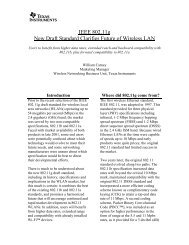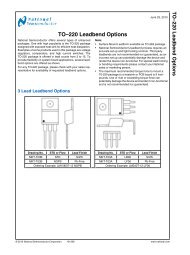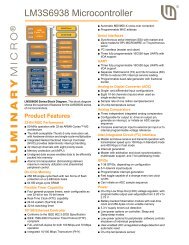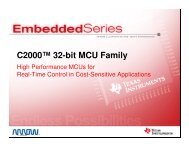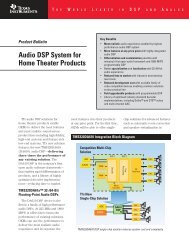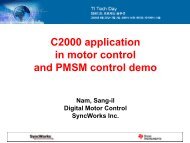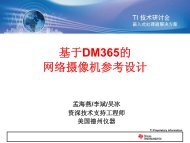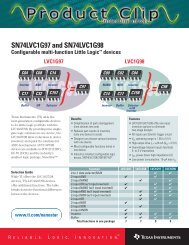IEEE IRPS Douglass - Texas Instruments
IEEE IRPS Douglass - Texas Instruments
IEEE IRPS Douglass - Texas Instruments
Create successful ePaper yourself
Turn your PDF publications into a flip-book with our unique Google optimized e-Paper software.
Lifetime Estimates and Unique Failure Mechanisms<br />
of the Digital Micromirror Device (DMD)<br />
ABSTRACT<br />
The Digital Micromirror Device TM (DMD TM ) has made great strides<br />
in both performance and reliability. Each device consists of more than<br />
500,000 individually addressable micromirrors. Digital Light<br />
Processing TM technology, based on the DMD, has been used in such<br />
diverse products as projection displays with film-like projected images<br />
and photographic-quality printers. Reliability testing of the DMD<br />
has demonstrated greater than 100,000 operating hours and more than<br />
1 trillion mirror cycles.<br />
This paper discusses DMD reliability development activities; failure<br />
modes investigated (e.g., hinge fatigue, hinge memory, stuck<br />
mirrors, and environmental robustness); various acceleration techniques<br />
(e.g., temperature and duty cycle); corrective actions implemented;<br />
and the resulting evidence that the DMD is exceeding original reliability<br />
goals.<br />
INTRODUCTION<br />
The use of a DMD to digitize light is referred to as Digital Light<br />
Processing TM or DLP TM . A DLP subsystem consists of a light source,<br />
optics, color filters, digital processing and formatting, a DMD, and a<br />
projection lens, as shown in Figure 1. References [1] and [2] describe<br />
DLP in more detail and give additional examples.<br />
The DMD is an array of aluminum micromirrors monolithically<br />
fabricated over an array of SRAM cells. Each SRAM cell corresponds<br />
to a micromirror and allows each mirror to be individually addressed<br />
so as to rotate +10 degrees, limited by a mechanical stop. The<br />
micromirror superstructure is fabricated through a series of aluminum<br />
Digital Processing<br />
and Formatting<br />
DMD<br />
Color Filter<br />
Optics<br />
Projection<br />
Lens<br />
Figure 1. An example of a DLP projection system<br />
using a single DMD<br />
M.R. <strong>Douglass</strong><br />
<strong>Texas</strong> <strong>Instruments</strong>, Digital Imaging<br />
Post Office Box 869305, MS 8477<br />
Plano, <strong>Texas</strong> 75086<br />
972-575-6774; fax: 972-575-0457; e-mail: m-douglass@ti.com<br />
Light Source<br />
Mirror<br />
Spring Tip<br />
Mirror<br />
Address<br />
Electrode<br />
Yoke<br />
Address<br />
Electrode<br />
Bias-Reset<br />
Bus<br />
Figure 2. Exploded view of a DMD pixel<br />
Torsion Hinge<br />
Yoke<br />
Yoke<br />
and Hinge<br />
Via 2 Contact<br />
to CMOS<br />
Metal-3<br />
Landing<br />
Site<br />
(Layers)<br />
Mirror<br />
CMOS<br />
Memory<br />
metal depositions, oxide masks, metal etches, and organic spacers.<br />
The organic spacers are subsequently ashed away to leave the<br />
micromirror structure free to move. Reference [1] discusses this process<br />
in more detail. Figure 2 shows an exploded view of a micromirror.<br />
The mirror is rotated as a result of electrostatic attraction between<br />
the mirror structure and the underlying memory cell. The mirror and<br />
yoke are connected to a bias/reset voltage. The address electrodes are<br />
connected to the underlying CMOS memory through via contacts.<br />
Movement of the mirror is accomplished by storing a 1 or a 0 in the<br />
memory cell (one address electrode at ground and the other address<br />
electrode at V DD ) and applying a bias voltage to the mirror/yoke<br />
structure. When this occurs, the mirror is attracted to the side with the<br />
largest electrostatic field differential, as shown in Figure 3. To release<br />
the mirror, a short reset pulse is applied to the mirror that excites the<br />
resonant mode of the structure and the bias voltage is removed. The<br />
combination of these two occurrences results in the mirror leaving<br />
the landing site. The mirror lands again when the bias voltage is<br />
reapplied [2]. Mirror control during this transition is a critical<br />
aspect of device reliability and is discussed in subsequent sections of<br />
this paper.<br />
Each micromirror is 16 μm square. The array places each<br />
micromirror on a 17 μm pitch, leaving a gap of less than 1μm between
Mirror –10 deg<br />
Hinge<br />
Yoke<br />
Spring Tip<br />
Figure 3. Two DMD pixels<br />
the micromirrors. This results in a >90% fill factor and is one significant<br />
advantage of the DMD. The configuration of the array is flexible,<br />
depending on the application. DMD array sizes have been produced<br />
in the following configurations: 840 × 1 (first production DMD used<br />
for low-resolution printing), 640 × 480 (VGA resolution), 848 × 600<br />
(SVGA resolution), 1024 × 768 (XGA resolution), and<br />
1280 × 1024 (SXGA resolution), as well as demonstrations of other<br />
array sizes, such as, 7056 × 64 (high-resolution printing) and<br />
2048 × 1024 (HDTV demonstration for a DARPA contract). Figure 4<br />
is a photograph of a small portion of an array.<br />
DMD RELIABILITY DEVELOPMENT<br />
Mirror +10 deg<br />
Reliability development activities started in early 1992. We began<br />
with a detailed failure modes and effects analysis (FMEA) so that we<br />
could brainstorm potential failure modes and mechanisms. We then<br />
wrote a test plan to verify these failures as well as to highlight any<br />
unanticipated failure modes. We used <strong>Texas</strong> <strong>Instruments</strong> standard semiconductor<br />
qualification test requirements as our baseline, including<br />
applicable tests such as storage life, temperature cycling, thermal shock,<br />
moisture resistance, vibration, wire bond strength, and die shear. The<br />
standard test requirements adequately covered package and die integrity<br />
concerns but did not specifically address microelectromechanical<br />
systems (MEMS) concerns associated with a three-dimensional, moving<br />
integrated circuit.<br />
To address the MEMS aspects of the DMD, the test plan focused<br />
on such obvious potential failure mechanisms as:<br />
• Hinges breaking (fatiguing) over time as a result of routine<br />
operation<br />
• Mirrors breaking as a result of handling (vibration/shock)<br />
• Device lifetime limitations caused by high operating temperatures<br />
• Device lifetime limitations due to intense light exposure.<br />
CMOS<br />
Substrate<br />
We designed a series of tests to address each of these concerns as<br />
well as to try to simulate how a DMD would be used in actual applications.<br />
As our reliability development program progressed, we identified<br />
several acceleration techniques that allowed us to highlight subtle failure<br />
modes and, in turn, implement design improvements much more<br />
rapidly.<br />
As the tests progressed, we soon realized that a DMD is more than<br />
a MEMS device. A DMD has unique optical requirements as well as<br />
chemical properties that offer challenges we did not consider. In other<br />
words, the DMD is a microsystem with mechanical-electrical-opticalchemical<br />
properties that all need to be jointly optimized [3,4].<br />
References [5] and [6] summarize some of the early test results<br />
and potential failure modes. These failure modes and others are discussed<br />
in more detail in the next section.<br />
UNIQUE FAILURE MECHANISMS INVESTIGATED<br />
Hinge Fatigue<br />
Figure 4. Top surface of micromirror array<br />
Hinge fatigue was certainly one of the most significant concerns.<br />
Simple calculations (a mirror switching once every 200 microseconds<br />
for 5 years at 1000 operating hours per year) showed that each mirror<br />
element needed to rotate, or switch, more than 90 × 10 9 times to ensure<br />
a reliable product. Initial finite element analyses using bulk<br />
properties of aluminum highlighted this as a potential concern. A life<br />
test was designed to accelerate the number of mirror cycles per second<br />
by a factor of 10. The test accomplished this by switching the<br />
mirrors more rapidly (once every 20 microseconds) than would occur<br />
during actual operation (a time-based average of 200 to 300 microseconds).<br />
On a small sample, we rapidly exceeded 100 × 10 9 with no<br />
hinge fatigue failures. We increased the sample size and the results<br />
were similarly successful. Several devices also remained on test for<br />
more than 10 12 cycles with no evidence of hinge fatigue.<br />
More recently, we repeated this test on DMDs sampled from the<br />
production flow. Four devices (three with zero defects and one with<br />
one nonfunctional mirror at the start) have been on test for nearly 19,000<br />
hours. Each device has exceeded 1.7 × 10 12 cycles with no evidence of<br />
hinge fatigue. One device has one added defect. After 1.7 × 10 12 cycles,<br />
all functional mirrors were still functional except for the one added<br />
defect, which does not appear to be due to fatigue. Because each DMD<br />
in this test has 307,200 functional mirrors (640 × 480) and each mirror<br />
switched more than 1.7 × 10 12 times, the test has demonstrated more<br />
than 2 × 10 18 total micromirror movements with only one added<br />
micromirror defect and no device failures!<br />
Additional research into why demonstrated hinge lifetimes greatly<br />
exceeded our initial finite element analysis estimates proved that<br />
MEMS models need to use thin-film properties of metal, not bulk properties.<br />
Bulk models of macroscopic fatigue are based on dislocations<br />
coalescing or “piling up” at the surface of the metal. As the density of<br />
the dislocations increases, fatigue cracks form. The dislocations then
accumulate at the fatigue crack, further concentrating mechanical<br />
stresses, until the yield point is exceeded and breakage occurs.<br />
With extremely thin films such as the DMD hinge, the material is<br />
only one grain thick, thus providing two free surfaces to restrain any<br />
dislocations. Because of this, the thin film material does not accumulate<br />
a high enough density of dislocations to form fatigue cracks. In<br />
addition to the test results, hinges from several devices were thoroughly<br />
inspected for fatigue damage using a transmission electron microscope<br />
(TEM). Even at the sections of the hinge where the most stress was<br />
expected, there was no evidence of dislocations, grain irregularity, or<br />
fatigue.<br />
As we refined our finite element analysis models based on thin<br />
film properties and actual test results, we were able to predict the performance<br />
of new designs that matched test results. We now estimate,<br />
as we have demonstrated, that hinges will not break during at least 10<br />
years of normal use in any application and more than 50 years in most<br />
applications. To date, we have not identified the point at which a hinge<br />
wears out.<br />
A significant lesson learned from this potential failure mechanism<br />
is that a thorough understanding of thin film properties as well as models<br />
that support thin film material are critical to successful MEMS development.<br />
Hinge Memory<br />
One of the most significant failure modes identified during our<br />
development program and also one of the last remaining life-limiting<br />
modes is called “hinge memory.” Hinge memory occurs as a mirror is<br />
operated in the same direction for a long period of time. For example,<br />
a mirror continually landed on the off-side (that is, when the mirror<br />
appears dark in a projected image) will exhibit a small amount of residual<br />
tilt when all voltages are removed, as shown in Figure 5.<br />
The mirror will continue to operate properly as long as the electrostatic<br />
fields can direct the mirror to the proper state. When the residual<br />
tilt exceeds approximately 35 to 40% of the 10 degree rotation angle,<br />
most mirrors will not function properly and the pixel will appear non-<br />
Average Number of Nonfunctional Mirrors<br />
1,000,000<br />
100,000<br />
10,000<br />
1,000<br />
100<br />
10<br />
1<br />
0<br />
0 Hours<br />
161 Hours<br />
345 Hours<br />
782 Hours<br />
1150 Hours<br />
Curve A<br />
12 14<br />
16 18<br />
Bias Voltage<br />
ON OFF<br />
Figure 5. A mirror that does not return to a flat position after<br />
electrostatic fields are removed exhibits “hinge memory.”<br />
functional to the observer. Although the address state under the mirror<br />
is changing, when the bias voltage is reapplied to the mirror, the electrostatic<br />
forces on the off-side are greater than those on the on-side<br />
because of the smaller distance. Thus, the mirror will land only to the<br />
off-side.<br />
The factors that contribute to hinge memory consist of operating<br />
temperature and mirror duty cycle. (For hinge memory calculations,<br />
duty cycle is the percentage of time the mirrors are addressed to one<br />
side in relation to the other. For instance, a 95/5 duty cycle means the<br />
mirrors touch the on-side 95% of the time and the off-side 5% of the<br />
time. A duty cycle of 50/50 means the mirrors touch both sides equally<br />
and no hinge memory occurs.)<br />
To evaluate DMD performance, we have developed a measure of<br />
hinge memory using our DMD optical test equipment. The test equipment<br />
sweeps the bias voltage while it counts the number of functional<br />
mirrors at each voltage step. This is referred to as a bias voltage sweep<br />
or V bias curve. Figure 6 shows a series of V bias curves. The Y-axis shows<br />
the number of nonfunctional mirrors; the X-axis shows the bias voltage.<br />
At low bias voltages, mirrors will not land because there are<br />
insufficient electrostatic forces. As the test equipment increases the<br />
bias voltage, more mirrors become functional.<br />
To accelerate hinge memory, we have established a life test using<br />
the standard test conditions of 65 °C and 95/5 duty cycle. As residual<br />
tilt builds up in a DMD, a larger bias voltage is required to land the<br />
mirror on both sides. This is evident in Figure 6. Curve A is the average<br />
V bias curve for a group of DMDs as fabricated. After life testing the<br />
devices at high temperature and high duty cycle, the curve shifts to the<br />
Curve B<br />
20 22 24<br />
Figure 6. Series of bias voltage curves for a group of DMDs. Shifting of these curves is a measure of hinge memory.
Bias Voltage (Average)<br />
22.0<br />
21.0<br />
20.0<br />
19.0<br />
18.0<br />
17.0<br />
16.0<br />
0 200<br />
400 600<br />
Time (Hours)<br />
right, indicating a need for higher bias voltage to maintain mirror functionality.<br />
Curve B is the average V bias curve for the same group of<br />
DMDs after 1150 hours of operation at 65 °C and 95/5 duty cycle.<br />
This series of curves is typical of device performance, and the shape<br />
of the curves is consistent from device to device.<br />
Because the curves are consistent, we can take representative points<br />
and plot their shift in relation to time. Figure 7 shows a plot of V bias,max<br />
(the bias voltage at which the last mirror becomes functional) and V bias,50<br />
(the median of the V bias curve). Notice that both curves are parallel and<br />
that the rate of change is slowing as the test progresses. This, again, is<br />
typical of all DMDs.<br />
Hinge memory on any given device follows a curve similar to that<br />
shown in Figure 7. Several hundred devices were sampled to determine<br />
their behavior over time. We placed each device on a life test at<br />
V bias, Max<br />
V bias, 50<br />
800 1000 1200<br />
Figure 7. Plot of V bias,max and V bias,50 as a function of time. These parametric curves have been used to monitor<br />
process control, implement design improvements, and predict DMD lifetimes<br />
Frequency<br />
50<br />
45<br />
40<br />
35<br />
30<br />
25<br />
20<br />
15<br />
10<br />
5<br />
0<br />
.024 .033 .042 .050 .059 .067 .076 .085 .093 .102 .111 .119 .128 More<br />
Bin(Delta Vb,50 )<br />
100.00%<br />
90.00%<br />
80.00%<br />
70.00%<br />
60.00%<br />
50.00%<br />
40.00%<br />
30.00%<br />
20.00%<br />
10.00%<br />
Figure 8. Distribution of V bias,50 shift after 160 hours of accelerated life test (high temperature and high duty cycle).<br />
This is a statistically normal distribution.<br />
00%<br />
the same test conditions (65 °C, 95/5 duty cycle) and tested them again<br />
after 160 hours. By comparing the V bias,50 before the life test and after<br />
160 hours, we found that the V bias,50 shift is a normal distribution, as<br />
shown in Figure 8. Now that we know this phenomenon is predictable,<br />
we can estimate lifetime by extrapolating time and stress after a<br />
shortened life test. Based on a series of tests with devices operating at<br />
various temperatures and duty cycles, we have determined that temperature<br />
is the dominant factor for hinge memory lifetime. Figure 9<br />
shows projected lifetimes at various temperatures and the performance<br />
improvements achieved since we initiated the reliability development<br />
effort.<br />
The root cause of hinge memory is metal creep of the hinge material.<br />
We evaluated alternate materials and process enhancements to<br />
determine if we could affect hinge memory by reducing metal creep.<br />
Through experimentation and the use of the parametric curves described
Hours<br />
1,000,000<br />
100,000<br />
10,000<br />
1,000<br />
100<br />
10<br />
25<br />
above, we selected an improved hinge material that did not exhibit the<br />
same degree of metal creep. This increased lifetime by a factor of approximately<br />
5 but was still not sufficient for product reliability, since<br />
we estimated a worst-case (65 °C, 95/5 duty cycle) lifetime of only<br />
1000 hours.<br />
The next significant improvement was the implementation of<br />
stepped V DD and a “bipolar reset.” Stepped V DD provides a higher<br />
voltage to the address electrode while the mirror is in transition to the<br />
proper side. Bipolar reset uses a positive bias voltage to land the mirrors<br />
and a negative reset voltage to resonate the mirrors. These two changes<br />
provide a greatly increased electrostatic field differential and allow<br />
the mirrors to be dynamically controlled over a wider range of hinge<br />
memory. As a result of having better control of the mirror during its<br />
transition, DMD lifetime increased by another factor of five to about<br />
5000 hours. At normal DMD operating temperatures of 35 to 45 °C<br />
and a high duty cycle of 95/5, we extrapolate DMD lifetimes of more<br />
than 100,000 hours. At typical duty cycles, such as 85/15 and 75/25,<br />
the lifetime is even higher.<br />
It is evident from this discussion that thermal management is integral<br />
to DMD lifetimes. There are several sources of heat that could<br />
contribute to hinge memory and, therefore, shortened DMD lifetime.<br />
The primary source is radiant energy from the light source. Although,<br />
this would appear to be a significant source of heat, in reality, the<br />
mirror surface reflects most of the energy. Radiant energy striking the<br />
package is much more likely to be absorbed and heat up the entire<br />
package. System apertures and optical integrators are very effective at<br />
reducing the temperature of the DMD package. Since the ceramic package<br />
is an inefficient thermal conductor, most applications attach a<br />
simple heatsink and radiator to the back of the package. This can dissipate<br />
sufficient thermal energy to maintain the DMD at just a few<br />
degrees above its ambient. The second source of thermal energy is<br />
from the projector assembly surrounding the DMD. Significant sources<br />
of heat in a projector include: lamp, lamp ballast, power supply, and<br />
electronics. Efficient and well-designed thermal management is necessary<br />
to ensure that the ambient temperature surrounding the DMD is<br />
maintained at a reasonable level. A third, but insignificant, source of<br />
heat is self-heating of the DMD CMOS.<br />
In most applications developed to date, the DMD operates at<br />
temperatures only 7 to 10 °C above the projector ambient. Thus, even<br />
35<br />
1997 Hinge<br />
1992 Hinge<br />
Normal<br />
Operating<br />
Conditions<br />
Longer DMD lifetime at<br />
less stressful duty cycle<br />
75/25 Duty Cycle<br />
45 55<br />
DMD Operating Temperature (C)<br />
65 75 85<br />
with a projector continuously operating in an ambient temperature of<br />
40 °C, the DMD is operating below 50 °C, thus ensuring a lifetime<br />
greater than 40,000 hours. A thorough discussion of DMD thermal<br />
management techniques can be found in reference [7].<br />
We have recently identified additional improvements to the hinge<br />
material. These changes are expected to further reduce metal creep<br />
and, therefore, increase robustness for operation at high temperature<br />
by at least another order of magnitude. As these improvements are<br />
realized, the resulting reduction in hinge memory can allow more flexibility<br />
in DMD design, DMD control, DMD operating limits, and<br />
system thermal management requirements.<br />
Nonfunctional (Stuck) Mirrors<br />
85/15 Duty Cycle<br />
95/5 Duty Cycle<br />
Figure 9. DMD lifetime estimates when operated at high temperature (65 °C) and high duty cycle<br />
One of the most obvious defects in a DMD array is the appearance<br />
of a nonfunctional mirror. There are numerous potential causes for<br />
improper mirror function. As discussed in the previous section, hinge<br />
memory could eventually result in a mirror appearing to be stuck on<br />
one side or the other. It is still functional, but the electrostatic field is<br />
not sufficient to move the mirror from one side to the other.<br />
Other conditions that contribute to nonfunctional mirrors are particulate<br />
contamination, surface residue, capillary condensation, CMOS<br />
defects, and van der Waals forces.<br />
Most mirror defects in today’s delivered DMDs can be traced to a<br />
particle, either on the surface of the mirror or under the mirror. A particle<br />
in either location, if it is of sufficient size and in a critical location,<br />
can result in improper mirror operation. A particle may be wedged<br />
between mirrors (thus interfering with mirror movement); the particle<br />
may be on the surface of the mirror (thus affecting mirror rotation<br />
dynamics); a particle may have affected the mirror during processing<br />
and damaged a hinge; or a conductive particle can result in a highresistance<br />
short on the address electrode so that the mirror is not<br />
addressed properly. We have observed instances of all these defects<br />
during DMD fabrication.<br />
As in most wafer fabs, particles are the number one contributor to<br />
yield loss, and the DMD is no different. In addition to causing fabrication<br />
yield loss, particles can contribute to reliability failures since the<br />
mirror array is exposed to any loose particles in the package cavity.
Average Number of Nonfunctional Mirrors<br />
100000<br />
10000<br />
1000<br />
100<br />
10<br />
1<br />
0<br />
Curve A<br />
Curve B<br />
0 3 6 9 12 15 18 21 24 27 30 33 36 39<br />
Reset Voltage<br />
Figure 10. V reset curves indicating qualitative measurement<br />
of surface adhesion<br />
Our particle reduction activity is continuously resulting in improved<br />
yields. More importantly, the effort is further reducing our reliability<br />
risk. There are now fewer opportunities for mobile particles that may<br />
eventually result in premature mirror failure or damage.<br />
The second most prevalent cause of nonfunctional mirrors is the<br />
existence of a surface contaminant or residue at the mirror tip landing<br />
point. The contaminant may contribute to increased surface adhesion,<br />
which prevents a mirror from functioning. We observe this occasionally<br />
as a result of improper surface cleaning during the superstructure<br />
processing. Gross processing errors that would result in premature device<br />
failure are readily identified during our normal burn-in and<br />
screening steps. Reliability sample testing identifies more subtle process<br />
variations. Parameters are measured based on a reset voltage sweep<br />
or V reset curve, much the same as the V bias curve discussed in the hinge<br />
memory section of this paper. DMD optical test equipment sweeps the<br />
reset voltage while it counts the number of functional mirrors at each<br />
voltage step. This is referred to as a V reset curve (Figure 10). The Y-axis<br />
shows the number of nonfunctional mirrors; the X-axis shows the reset<br />
voltage. At low reset voltages, mirrors will not release because of<br />
the forces holding the mirrors to the surface. As the reset voltage is<br />
increased, more mirrors release from the surface as the mechanical<br />
energy stored in the mirror overcomes the forces holding the mirror<br />
tips to the landing surface. At even higher reset voltages, energy is<br />
added to the mirror by pulsing it at its resonant frequency.<br />
In this test, we are able to measure the distribution of surface adhesion<br />
across the DMD by reducing the magnitude of the voltage pulse<br />
used to excite the mirror. As the magnitude of the voltage is reduced<br />
from its maximum, any mirrors with excessive surface adhesion cease<br />
to function. As the sweep continues, we can develop a distribution<br />
curve that represents the adhesion signature of each device. Figure 10<br />
provides an example of two curves taken after 160 hours of life test.<br />
Curve A is the distribution of mirrors from a sample of production<br />
DMDs (control devices) and curve B is the distribution of mirrors from<br />
a proposed process change (test devices). It is apparent that the test<br />
devices have a small number of mirrors that exhibit surface adhesion<br />
after the test, whereas the control devices are unchanged. Based on<br />
this information, the test devices were deemed “not as robust” as the<br />
control devices, and the process was further optimized before we in-<br />
Figure 11. Closeup image of a micromirror landing tip showing a<br />
spring tip. The spring not only absorbs energy during landing but<br />
stores energy for more efficient mirror release.<br />
corporated the design change. As a result of monitoring the shift in<br />
this parametric curve over time, we have developed a leading indicator<br />
of potential reliability degradation attributable to excessive surface<br />
adhesion.<br />
Before DMD production was started in 1996, the V reset parametric<br />
curve indicated that surface adhesion was too great to deliver a reliable<br />
device. An innovative approach to overcoming surface adhesion<br />
was the addition of “springs” to the landing tips of the mirrors (Figure<br />
11). As bias is applied to a mirror, the mirror lands, the springs deform,<br />
and energy is stored in the springs. When a reset pulse is applied<br />
and bias voltage is removed, the stored energy pushes the mirror tip<br />
off the surface. This has virtually eliminated the impact of surface<br />
adhesion due to surface contamination.<br />
The remaining three contributors to nonfunctional mirrors, capillary<br />
condensation, CMOS defects, and van der Waals forces are minor<br />
contributors to reliability degradation. We control capillary condensation<br />
by sealing the device in a controlled atmosphere and maintaining<br />
this atmosphere through robust package design methods. Although<br />
CMOS defects are a contributor to yield loss, extensive life testing has<br />
shown no evidence of CMOS parametric degradation contributing to<br />
added defects. Surface adhesion due to van der Waals forces (molecular<br />
surface forces) are minimized by applying a special coating to the<br />
landing surface. The spring tips also provide additional margin against<br />
any increase in surface adhesion forces.<br />
Light Exposure<br />
More than 300 DMDs have been exposed to intense, broad-spectrum<br />
light while operating for more than 1000 hours, with some operating<br />
for well over 5000 hours. Throughout all of these tests, there was no<br />
evidence that light exposure resulted in a fundamental performance<br />
degradation. Many of the devices were tested again after light exposure,<br />
and the reset curves and bias curves (as described previously) were<br />
unchanged from initial outgoing tests. Destructive analyses, such as<br />
residual gas analysis (RGA), X-ray photoelectron spectroscopy (XPS),<br />
and time-of-flight secondary ion mass spectrometry (ToFSIMS), were<br />
also performed on several devices after light exposure. Again, there<br />
was no evidence of fundamental chemical degradation or damage to<br />
the landing surface or superstructure.
Particles |...............................68%<br />
Window Quality |.............18%<br />
Random Pixel |.........10%<br />
Other |...4%<br />
Figure 12. Pareto analysis of DMD field returns<br />
Occasionally we noticed a slight statistical trend toward some<br />
DMDs having more defects when exposed to UV and near-violet light.<br />
There were also several DMDs that failed because of stuck pixels in<br />
preproduction projectors. To better understand this phenomenon, we<br />
ran a series of tests using actual projectors. Each projector was modified<br />
to have a different UV cutoff filter. We found that DMDs were<br />
more likely to fail as a result of nonfunctional stuck pixels if exposed<br />
to light at wavelengths of 400 nm and below. A UV filter was, therefore,<br />
added to the DLP optics path to ensure a flux density of no more<br />
than 0.7 mW/cm 2 below 400 nm, most of which is beyond the visible<br />
spectrum of light. Since the addition of the UV filter, there have been<br />
no reported projector failures.<br />
ENVIRONMENTAL ROBUSTNESS<br />
One of the first steps we performed during the early stages of our<br />
reliability development program was to conduct a series of environmental<br />
tests similar to those performed in accordance with TI<br />
Semiconductor Group standards. These tests consisted of thermal<br />
shock, temperature cycling, moisture exposure, mechanical shock,<br />
vibration, acceleration, temperature storage, altitude, bond wire integrity,<br />
substrate attachment integrity, and ESD characterization. The<br />
superstructure was extremely robust [5]. The mirrors were not damaged<br />
by mechanical shock, vibration, or acceleration. There was no<br />
physical or parametric curve degradation due to temperature shock,<br />
cycling, or storage.<br />
These results, especially the robustness against vibration and shock,<br />
are surprising to some but easily explained. The micromirrors resonate<br />
at frequencies greater than 100 kHz. Normal handling occurs at<br />
frequencies less than 1000 Hz. Thus, the DMD micromirrors are unaffected<br />
by any vibration modes set up during assembly or handling.<br />
Although the mirrors were robust, the tests identified some weaknesses<br />
in the package that were subsequently corrected. The tests also<br />
demonstrated that loose particles in the package cavity can land on<br />
and damage the mirror superstructure. The evidence of mirror damage<br />
due to loose particles was the impetus to accelerate our particle reduction<br />
program to minimize our field reliability risk. The primary source<br />
of particles was found to be from the chemical interaction of the die<br />
attachment adhesive with the coating used to reduce surface adhesion.<br />
The secondary source was silicon particles, mostly from the edge of<br />
the die, and mostly due to the die sawing and separation process. Other<br />
miscellaneous particles (for example, carbon-based and aluminum)<br />
were found to come from handling, assembly, and equipment sources.<br />
Corrective actions to reduce our risk due to particles included the selection<br />
of a new die attachment adhesive, an improved wafer sawing<br />
process, better handling methods, more frequent particle monitoring,<br />
and numerous other process improvements throughout the fabrication<br />
line. Yield loss due to particles has been reduced by a significant percentage<br />
and continues to improve.<br />
LIFETIME DEMONSTRATIONS<br />
AND RELIABILITY ESTIMATES<br />
Through the use of accelerated life testing, the development of rudimentary<br />
models, and environmental qualification, we have identified<br />
what we believe to be the complete list of life-limiting factors. As<br />
discussed previously, hinge fatigue and environmental exposure are<br />
not life limiting. Particulate contamination appears to be random and<br />
not dependent on time or stress. We have not identified any correlation<br />
between light exposure and life. Through design robustness and process<br />
control, we have eliminated all known contributors to surface<br />
adhesion degradation. This leaves hinge memory. Because hinge<br />
memory is so predictable, we have easily estimated our lifetime to be<br />
greater than 100,000 hours, as long as the DMD die temperature is<br />
maintained at 45 °C or below.<br />
Although an actual lifetime of 100,000 hours has not yet been demonstrated,<br />
there is supporting evidence that DMD lifetime is measured<br />
in thousands of hours. Existing data through nearly 2 years of product<br />
deliveries have confirmed no DMD failures due to parametric curve<br />
degradation (bias voltage parametric curves and reset voltage parametric<br />
curves). Several DMDs remain on test through 19,000 actual<br />
operating hours with no failures to date. This certainly supports the<br />
test results and estimates.<br />
In terms of random failures, few devices have failed during enditem<br />
use. We anticipated that particles would dominate random failures,<br />
and that has proved to be true. Particles remain our primary cause of<br />
yield loss, but we have not observed a significant amount of customer<br />
returns caused by particles. In fact, even though particles are our primary<br />
pareto item (Figure 12), the field failure rate for all DMDs<br />
delivered to date is less than 0.2%. We have estimated a mean time<br />
between failures (MTBF) by using the total number of units shipped,<br />
multiplied by an estimate of usage hours per month, divided by the<br />
total number of reported DMD failures. Using conservative estimates<br />
for all three of these factors, we have a demonstrated MTBF (random<br />
failures) of 119,000 hours.<br />
SUMMARY<br />
This paper has highlighted DMD failure modes, failure mechanisms,<br />
and actions taken to improve reliability. Figure 13 presents a summary<br />
of DMD lifetime estimates as a result of major design<br />
enhancements implemented since 1992. The reliability development<br />
program has achieved the following milestones:<br />
• The DMD has been subjected to typical semiconductor environmental<br />
qualification tests and proved to be robust to all,<br />
including temperature cycling, mechanical shock, and vibration.<br />
• We have calculated an MTBF of greater than 119,000 hours<br />
based on actual field data.<br />
• We have projected a lifetime of more than 100,000 hours based<br />
on actual test results and modeling data developed for the DMD.<br />
The only life-limiting failure mechanism identified to date is<br />
temperature-accelerated hinge memory.<br />
• We have demonstrated more than 1.7 × 1012 mirror cycles with<br />
no hinge fatigue failures. This correlates to 95,000 hours of<br />
normal operation.
Estimated DMD Lifetime<br />
100,000<br />
Hrs<br />
10,000<br />
Hrs<br />
1000<br />
Hrs<br />
100<br />
Hrs<br />
10<br />
Hrs<br />
Range of Performance for<br />
Consumer Applications<br />
Range of Performance for<br />
First-Wave Products<br />
1992 1997<br />
In summary, test results and field performance have demonstrated<br />
that DMD reliability is surpassing its original projections.<br />
ACKNOWLEDGMENTS<br />
The author would like to thank all the members of the <strong>Texas</strong> <strong>Instruments</strong><br />
Digital Imaging Team for their creative and innovative<br />
solutions and their unwavering dedication to reliability. Special recognition<br />
should go to the test development team and the DMD<br />
characterization team, whose contributions helped us gain a more thorough<br />
understanding of the DMD.<br />
REFERENCES<br />
New Hinge<br />
Material<br />
Enhanced<br />
Packaging<br />
[1] L.J. Hornbeck, “Digital Light Processing and MEMS: Timely<br />
Convergence for a Bright Future” (Invited Plenary Paper),<br />
Proceedings SPIE, Vol. 2639, p.2, Micromachining and<br />
Microfabrication Process Technology (1995). Abstract Only.<br />
Color reprint of complete paper available. Call 1-888-DLP-BYTI<br />
(1-888-357-2984).<br />
Improved<br />
Processes<br />
Figure 13. Reliability development and lifetime improvement<br />
Bipolar<br />
Waveforms<br />
With Stepped<br />
V DD<br />
Spring Tip<br />
Superstructure<br />
Innovation<br />
[2] L.J. Hornbeck, “Digital Light Processing for High-Brightness,<br />
High-Resolution Applications” (Invited Paper), Proceedings.<br />
SPIE, Vol. 3013, pp. 27-40, EI ‘97 Projection Displays III (1997).<br />
[3] R.L. Knipe, “Challenges of a Digital Micromirror Device: Modeling<br />
and Design,” SPIE EurOpto Proceedings, Vol. 2783, pp.<br />
135-145 (June 1996).<br />
[4] L.J. Hornbeck, T.R. Howell, R.L. Knipe, and M.A. Mignardi,<br />
“Digital Micromirror Device TM —Commercialization of a Massively<br />
Parallel MEMS Technology,” Microelectronic Systems<br />
1997, DSC-Vol. 62, pp. 3-8, ASME International Mechanical<br />
Engineering Congress and Exposition (1997).<br />
[5] M.R. <strong>Douglass</strong> and D. M. Kozuch, “DMD Reliability Assessment<br />
for Large-Area Displays,” Society for Information Display<br />
International Symposium Digest of Technical Papers, Vol. 26 (Applications<br />
Session A3), pp. 49-52 (May 1995).<br />
[6] M.R. <strong>Douglass</strong> and C. Malemes, “Reliability of Displays Using<br />
Digital Light Processing,” SID ’96, San Diego, CA (May 1996).<br />
[7] J.D. Grimmett, “Thermal Analysis of a Light-Reflecting Digital<br />
Micromirror Device,” International Microelectronics and Packaging<br />
Society, San Diego, CA (Dec 1997).



